Comprehensive Comparison and Contrast of Onchocerciasis and Trachoma
VerifiedAdded on 2020/11/12
|6
|1212
|79
Report
AI Summary
This report provides a comprehensive comparison and contrast of onchocerciasis (river blindness) and trachoma, two significant infectious diseases affecting global health. It begins with an introduction to both diseases, highlighting their causative agents: the parasitic worm Onchocerca volvulus for onchocerciasis and the bacterium Chlamydia trachomatis for trachoma. The report then delves into the main body, detailing the symptoms, causes, and diagnostic methods for each disease. For onchocerciasis, the report discusses the role of the black fly as a vector and the symptoms such as skin changes, itching, and visual impairment. For trachoma, it focuses on the bacterium, its transmission, and symptoms including eye pain, swelling, and potential blindness. Furthermore, the report explores preventive measures and treatment options for both diseases, including the use of insect repellents, hygiene practices, antibiotics, and in some cases, surgery. A comparative analysis is provided, highlighting the key differences in vectors, symptoms, and prevention methods. The report concludes by summarizing the key aspects of both diseases and emphasizing the importance of hygiene and vector control in preventing their spread. The report is supported by several references to academic books and journals.
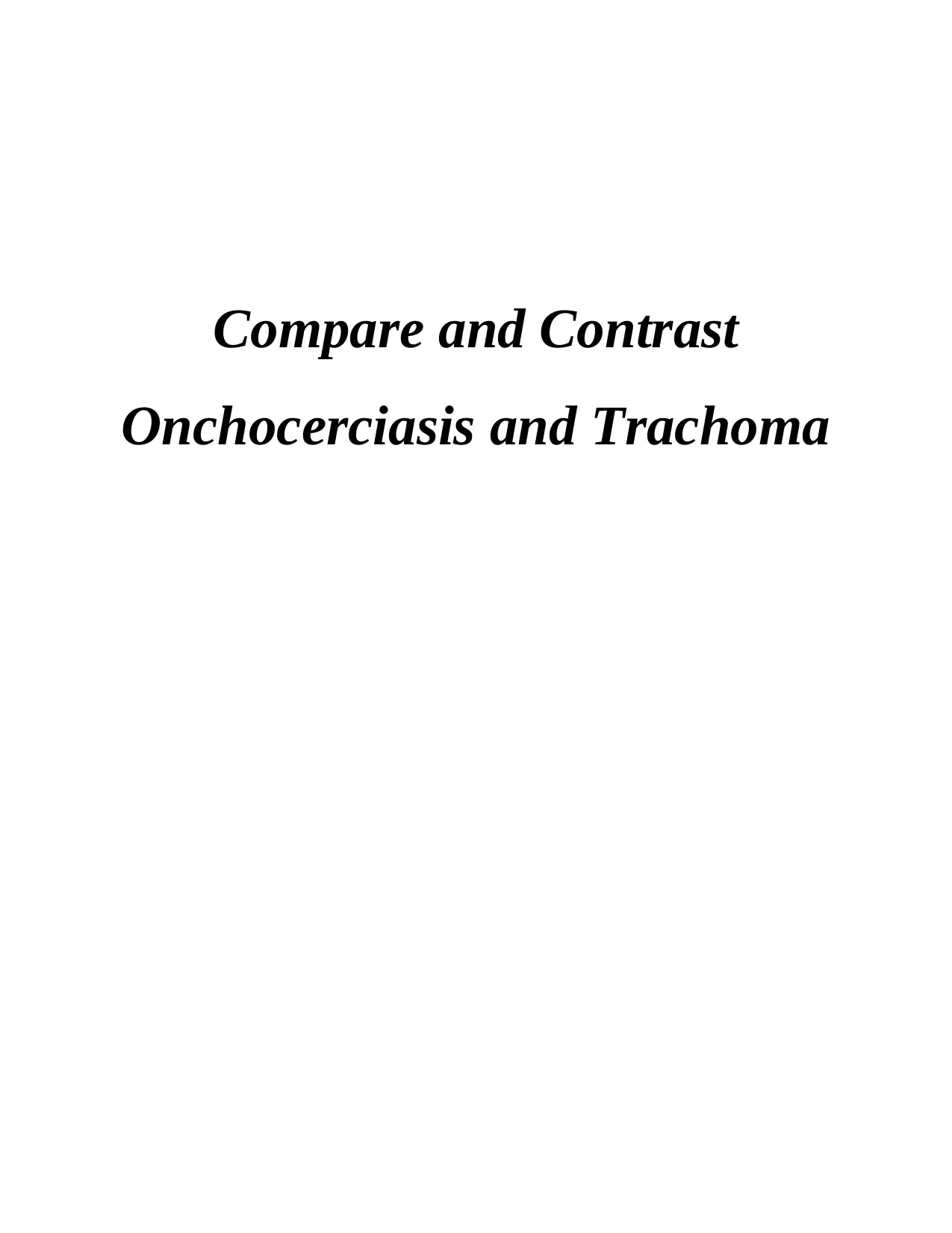
Compare and Contrast
Onchocerciasis and Trachoma
Onchocerciasis and Trachoma
Paraphrase This Document
Need a fresh take? Get an instant paraphrase of this document with our AI Paraphraser

Table of Contents
INTRODUCTION...........................................................................................................................1
MAIN BODY...................................................................................................................................1
CONCLUSION................................................................................................................................3
REFERENCES................................................................................................................................1
.........................................................................................................................................................1
.........................................................................................................................................................1
INTRODUCTION...........................................................................................................................1
MAIN BODY...................................................................................................................................1
CONCLUSION................................................................................................................................3
REFERENCES................................................................................................................................1
.........................................................................................................................................................1
.........................................................................................................................................................1
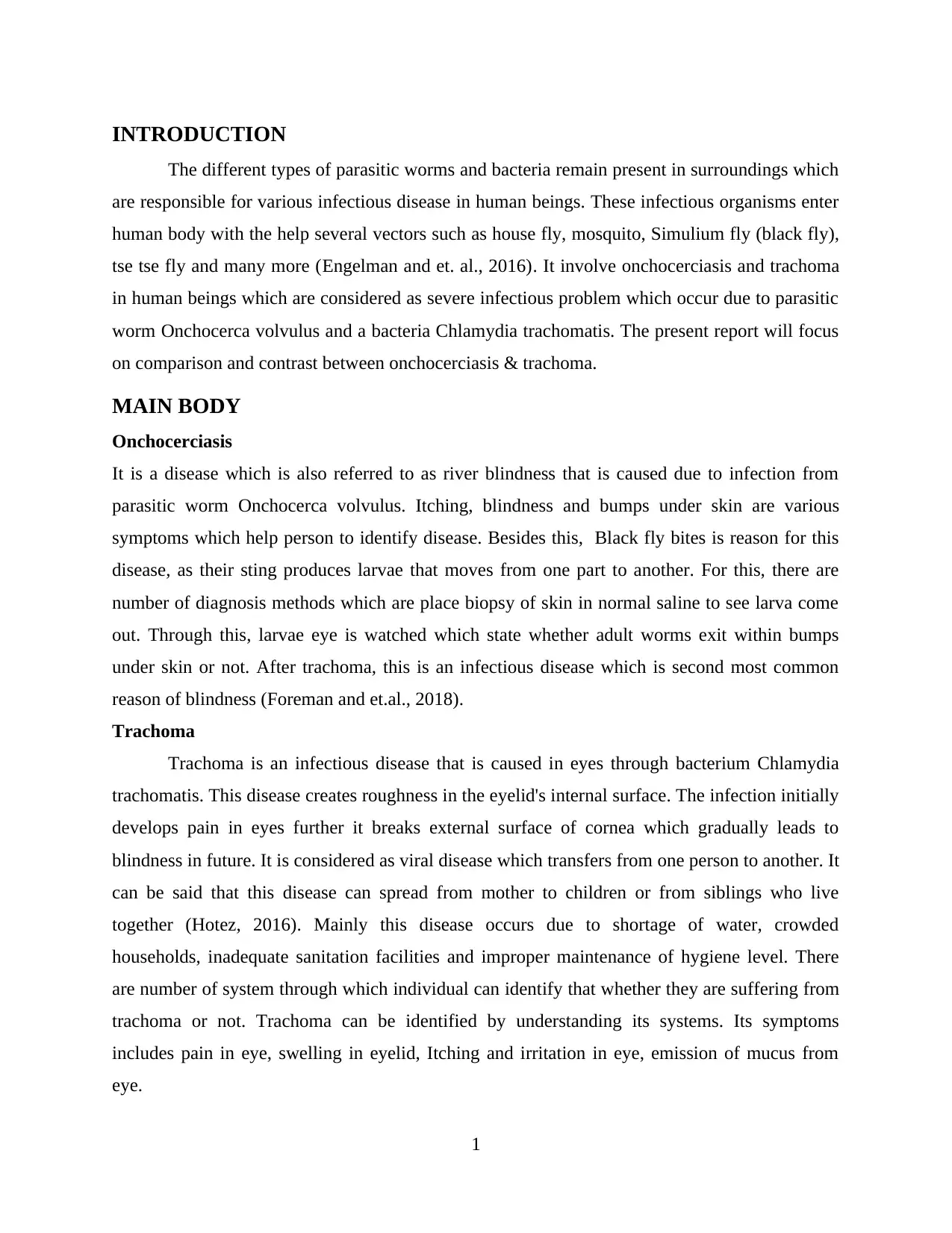
INTRODUCTION
The different types of parasitic worms and bacteria remain present in surroundings which
are responsible for various infectious disease in human beings. These infectious organisms enter
human body with the help several vectors such as house fly, mosquito, Simulium fly (black fly),
tse tse fly and many more (Engelman and et. al., 2016). It involve onchocerciasis and trachoma
in human beings which are considered as severe infectious problem which occur due to parasitic
worm Onchocerca volvulus and a bacteria Chlamydia trachomatis. The present report will focus
on comparison and contrast between onchocerciasis & trachoma.
MAIN BODY
Onchocerciasis
It is a disease which is also referred to as river blindness that is caused due to infection from
parasitic worm Onchocerca volvulus. Itching, blindness and bumps under skin are various
symptoms which help person to identify disease. Besides this, Black fly bites is reason for this
disease, as their sting produces larvae that moves from one part to another. For this, there are
number of diagnosis methods which are place biopsy of skin in normal saline to see larva come
out. Through this, larvae eye is watched which state whether adult worms exit within bumps
under skin or not. After trachoma, this is an infectious disease which is second most common
reason of blindness (Foreman and et.al., 2018).
Trachoma
Trachoma is an infectious disease that is caused in eyes through bacterium Chlamydia
trachomatis. This disease creates roughness in the eyelid's internal surface. The infection initially
develops pain in eyes further it breaks external surface of cornea which gradually leads to
blindness in future. It is considered as viral disease which transfers from one person to another. It
can be said that this disease can spread from mother to children or from siblings who live
together (Hotez, 2016). Mainly this disease occurs due to shortage of water, crowded
households, inadequate sanitation facilities and improper maintenance of hygiene level. There
are number of system through which individual can identify that whether they are suffering from
trachoma or not. Trachoma can be identified by understanding its systems. Its symptoms
includes pain in eye, swelling in eyelid, Itching and irritation in eye, emission of mucus from
eye.
1
The different types of parasitic worms and bacteria remain present in surroundings which
are responsible for various infectious disease in human beings. These infectious organisms enter
human body with the help several vectors such as house fly, mosquito, Simulium fly (black fly),
tse tse fly and many more (Engelman and et. al., 2016). It involve onchocerciasis and trachoma
in human beings which are considered as severe infectious problem which occur due to parasitic
worm Onchocerca volvulus and a bacteria Chlamydia trachomatis. The present report will focus
on comparison and contrast between onchocerciasis & trachoma.
MAIN BODY
Onchocerciasis
It is a disease which is also referred to as river blindness that is caused due to infection from
parasitic worm Onchocerca volvulus. Itching, blindness and bumps under skin are various
symptoms which help person to identify disease. Besides this, Black fly bites is reason for this
disease, as their sting produces larvae that moves from one part to another. For this, there are
number of diagnosis methods which are place biopsy of skin in normal saline to see larva come
out. Through this, larvae eye is watched which state whether adult worms exit within bumps
under skin or not. After trachoma, this is an infectious disease which is second most common
reason of blindness (Foreman and et.al., 2018).
Trachoma
Trachoma is an infectious disease that is caused in eyes through bacterium Chlamydia
trachomatis. This disease creates roughness in the eyelid's internal surface. The infection initially
develops pain in eyes further it breaks external surface of cornea which gradually leads to
blindness in future. It is considered as viral disease which transfers from one person to another. It
can be said that this disease can spread from mother to children or from siblings who live
together (Hotez, 2016). Mainly this disease occurs due to shortage of water, crowded
households, inadequate sanitation facilities and improper maintenance of hygiene level. There
are number of system through which individual can identify that whether they are suffering from
trachoma or not. Trachoma can be identified by understanding its systems. Its symptoms
includes pain in eye, swelling in eyelid, Itching and irritation in eye, emission of mucus from
eye.
1
⊘ This is a preview!⊘
Do you want full access?
Subscribe today to unlock all pages.

Trusted by 1+ million students worldwide
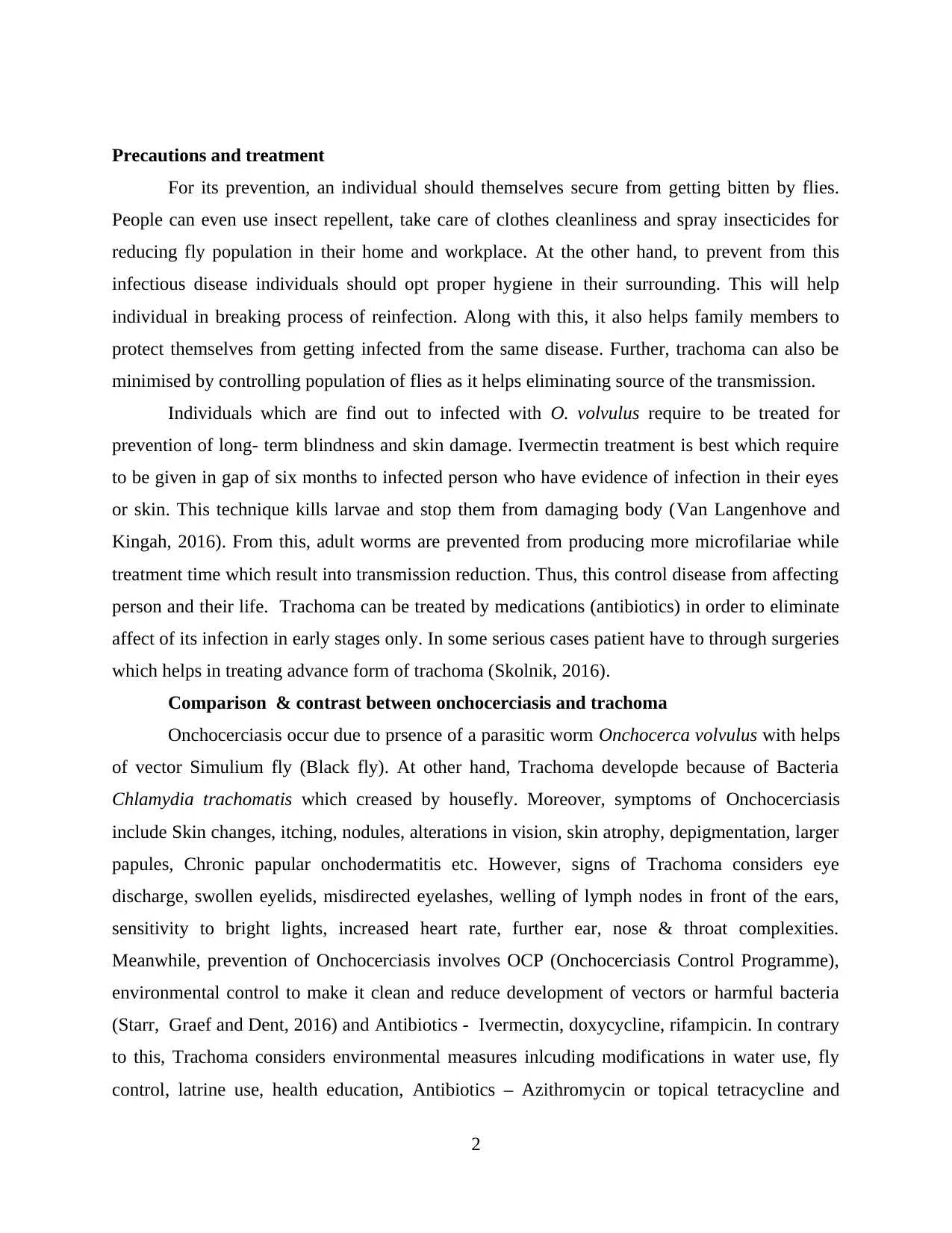
Precautions and treatment
For its prevention, an individual should themselves secure from getting bitten by flies.
People can even use insect repellent, take care of clothes cleanliness and spray insecticides for
reducing fly population in their home and workplace. At the other hand, to prevent from this
infectious disease individuals should opt proper hygiene in their surrounding. This will help
individual in breaking process of reinfection. Along with this, it also helps family members to
protect themselves from getting infected from the same disease. Further, trachoma can also be
minimised by controlling population of flies as it helps eliminating source of the transmission.
Individuals which are find out to infected with O. volvulus require to be treated for
prevention of long- term blindness and skin damage. Ivermectin treatment is best which require
to be given in gap of six months to infected person who have evidence of infection in their eyes
or skin. This technique kills larvae and stop them from damaging body (Van Langenhove and
Kingah, 2016). From this, adult worms are prevented from producing more microfilariae while
treatment time which result into transmission reduction. Thus, this control disease from affecting
person and their life. Trachoma can be treated by medications (antibiotics) in order to eliminate
affect of its infection in early stages only. In some serious cases patient have to through surgeries
which helps in treating advance form of trachoma (Skolnik, 2016).
Comparison & contrast between onchocerciasis and trachoma
Onchocerciasis occur due to prsence of a parasitic worm Onchocerca volvulus with helps
of vector Simulium fly (Black fly). At other hand, Trachoma developde because of Bacteria
Chlamydia trachomatis which creased by housefly. Moreover, symptoms of Onchocerciasis
include Skin changes, itching, nodules, alterations in vision, skin atrophy, depigmentation, larger
papules, Chronic papular onchodermatitis etc. However, signs of Trachoma considers eye
discharge, swollen eyelids, misdirected eyelashes, welling of lymph nodes in front of the ears,
sensitivity to bright lights, increased heart rate, further ear, nose & throat complexities.
Meanwhile, prevention of Onchocerciasis involves OCP (Onchocerciasis Control Programme),
environmental control to make it clean and reduce development of vectors or harmful bacteria
(Starr, Graef and Dent, 2016) and Antibiotics - Ivermectin, doxycycline, rifampicin. In contrary
to this, Trachoma considers environmental measures inlcuding modifications in water use, fly
control, latrine use, health education, Antibiotics – Azithromycin or topical tetracycline and
2
For its prevention, an individual should themselves secure from getting bitten by flies.
People can even use insect repellent, take care of clothes cleanliness and spray insecticides for
reducing fly population in their home and workplace. At the other hand, to prevent from this
infectious disease individuals should opt proper hygiene in their surrounding. This will help
individual in breaking process of reinfection. Along with this, it also helps family members to
protect themselves from getting infected from the same disease. Further, trachoma can also be
minimised by controlling population of flies as it helps eliminating source of the transmission.
Individuals which are find out to infected with O. volvulus require to be treated for
prevention of long- term blindness and skin damage. Ivermectin treatment is best which require
to be given in gap of six months to infected person who have evidence of infection in their eyes
or skin. This technique kills larvae and stop them from damaging body (Van Langenhove and
Kingah, 2016). From this, adult worms are prevented from producing more microfilariae while
treatment time which result into transmission reduction. Thus, this control disease from affecting
person and their life. Trachoma can be treated by medications (antibiotics) in order to eliminate
affect of its infection in early stages only. In some serious cases patient have to through surgeries
which helps in treating advance form of trachoma (Skolnik, 2016).
Comparison & contrast between onchocerciasis and trachoma
Onchocerciasis occur due to prsence of a parasitic worm Onchocerca volvulus with helps
of vector Simulium fly (Black fly). At other hand, Trachoma developde because of Bacteria
Chlamydia trachomatis which creased by housefly. Moreover, symptoms of Onchocerciasis
include Skin changes, itching, nodules, alterations in vision, skin atrophy, depigmentation, larger
papules, Chronic papular onchodermatitis etc. However, signs of Trachoma considers eye
discharge, swollen eyelids, misdirected eyelashes, welling of lymph nodes in front of the ears,
sensitivity to bright lights, increased heart rate, further ear, nose & throat complexities.
Meanwhile, prevention of Onchocerciasis involves OCP (Onchocerciasis Control Programme),
environmental control to make it clean and reduce development of vectors or harmful bacteria
(Starr, Graef and Dent, 2016) and Antibiotics - Ivermectin, doxycycline, rifampicin. In contrary
to this, Trachoma considers environmental measures inlcuding modifications in water use, fly
control, latrine use, health education, Antibiotics – Azithromycin or topical tetracycline and
2
Paraphrase This Document
Need a fresh take? Get an instant paraphrase of this document with our AI Paraphraser
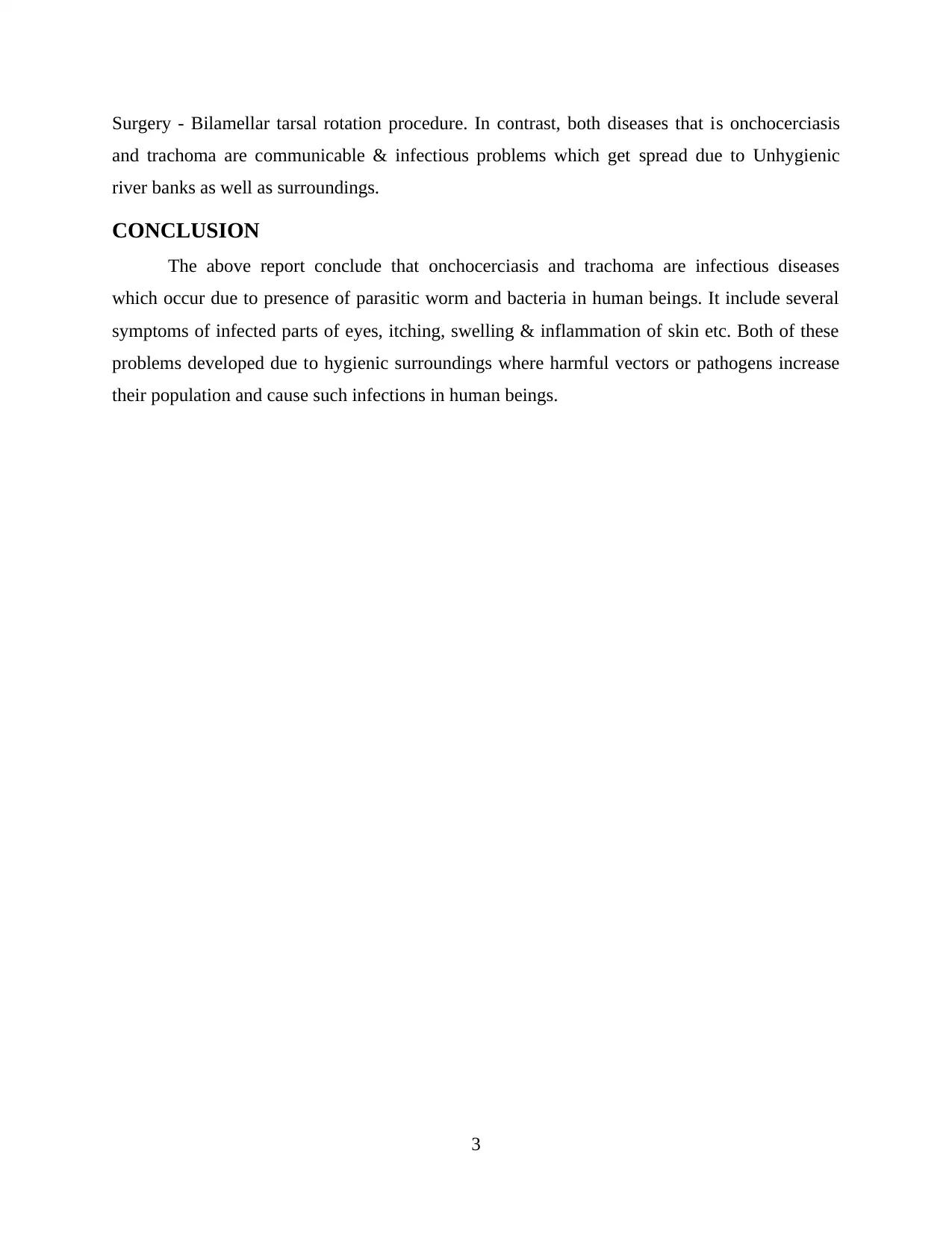
Surgery - Bilamellar tarsal rotation procedure. In contrast, both diseases that is onchocerciasis
and trachoma are communicable & infectious problems which get spread due to Unhygienic
river banks as well as surroundings.
CONCLUSION
The above report conclude that onchocerciasis and trachoma are infectious diseases
which occur due to presence of parasitic worm and bacteria in human beings. It include several
symptoms of infected parts of eyes, itching, swelling & inflammation of skin etc. Both of these
problems developed due to hygienic surroundings where harmful vectors or pathogens increase
their population and cause such infections in human beings.
3
and trachoma are communicable & infectious problems which get spread due to Unhygienic
river banks as well as surroundings.
CONCLUSION
The above report conclude that onchocerciasis and trachoma are infectious diseases
which occur due to presence of parasitic worm and bacteria in human beings. It include several
symptoms of infected parts of eyes, itching, swelling & inflammation of skin etc. Both of these
problems developed due to hygienic surroundings where harmful vectors or pathogens increase
their population and cause such infections in human beings.
3
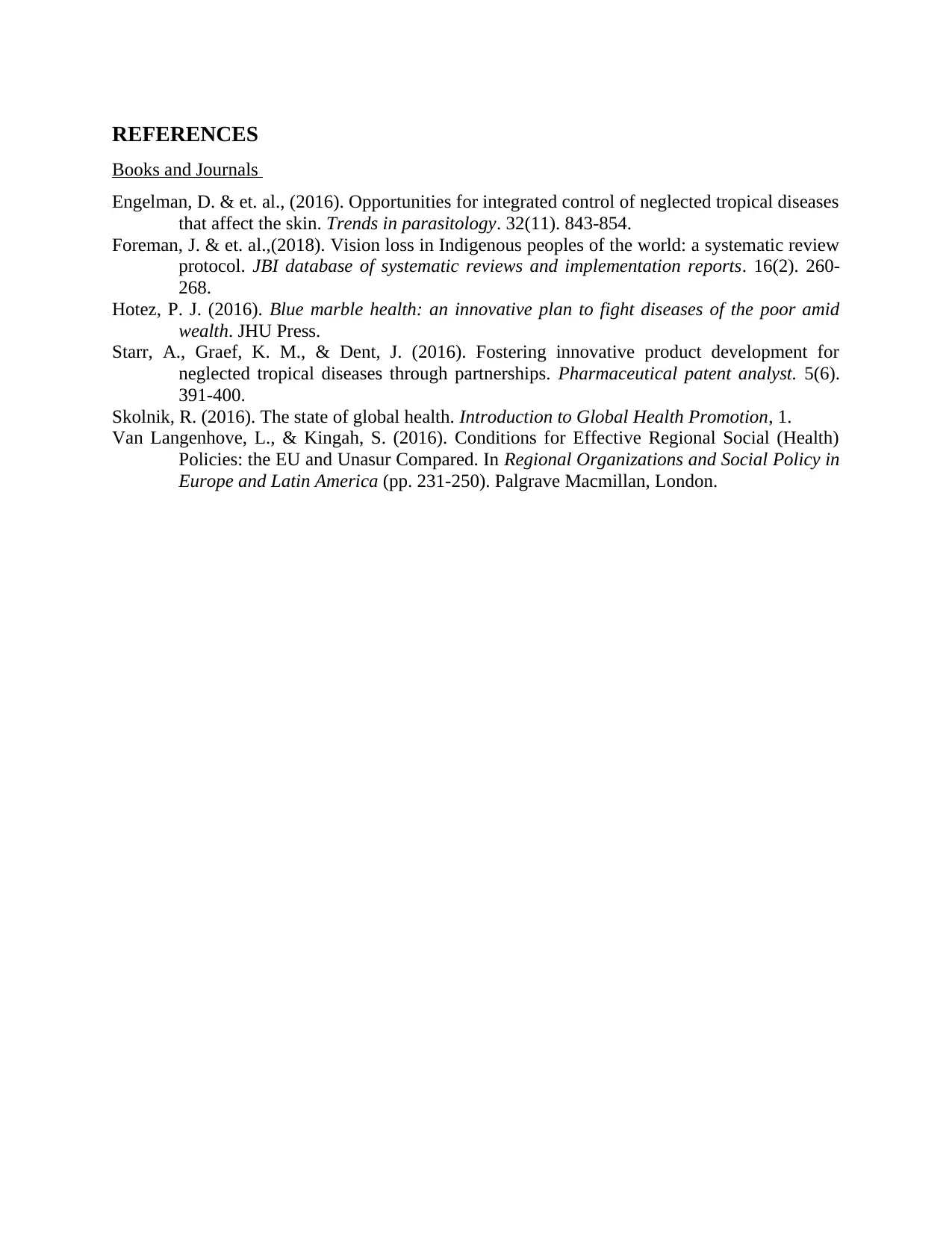
REFERENCES
Books and Journals
Engelman, D. & et. al., (2016). Opportunities for integrated control of neglected tropical diseases
that affect the skin. Trends in parasitology. 32(11). 843-854.
Foreman, J. & et. al.,(2018). Vision loss in Indigenous peoples of the world: a systematic review
protocol. JBI database of systematic reviews and implementation reports. 16(2). 260-
268.
Hotez, P. J. (2016). Blue marble health: an innovative plan to fight diseases of the poor amid
wealth. JHU Press.
Starr, A., Graef, K. M., & Dent, J. (2016). Fostering innovative product development for
neglected tropical diseases through partnerships. Pharmaceutical patent analyst. 5(6).
391-400.
Skolnik, R. (2016). The state of global health. Introduction to Global Health Promotion, 1.
Van Langenhove, L., & Kingah, S. (2016). Conditions for Effective Regional Social (Health)
Policies: the EU and Unasur Compared. In Regional Organizations and Social Policy in
Europe and Latin America (pp. 231-250). Palgrave Macmillan, London.
Books and Journals
Engelman, D. & et. al., (2016). Opportunities for integrated control of neglected tropical diseases
that affect the skin. Trends in parasitology. 32(11). 843-854.
Foreman, J. & et. al.,(2018). Vision loss in Indigenous peoples of the world: a systematic review
protocol. JBI database of systematic reviews and implementation reports. 16(2). 260-
268.
Hotez, P. J. (2016). Blue marble health: an innovative plan to fight diseases of the poor amid
wealth. JHU Press.
Starr, A., Graef, K. M., & Dent, J. (2016). Fostering innovative product development for
neglected tropical diseases through partnerships. Pharmaceutical patent analyst. 5(6).
391-400.
Skolnik, R. (2016). The state of global health. Introduction to Global Health Promotion, 1.
Van Langenhove, L., & Kingah, S. (2016). Conditions for Effective Regional Social (Health)
Policies: the EU and Unasur Compared. In Regional Organizations and Social Policy in
Europe and Latin America (pp. 231-250). Palgrave Macmillan, London.
⊘ This is a preview!⊘
Do you want full access?
Subscribe today to unlock all pages.

Trusted by 1+ million students worldwide
1 out of 6
Your All-in-One AI-Powered Toolkit for Academic Success.
+13062052269
info@desklib.com
Available 24*7 on WhatsApp / Email
![[object Object]](/_next/static/media/star-bottom.7253800d.svg)
Unlock your academic potential
Copyright © 2020–2025 A2Z Services. All Rights Reserved. Developed and managed by ZUCOL.


